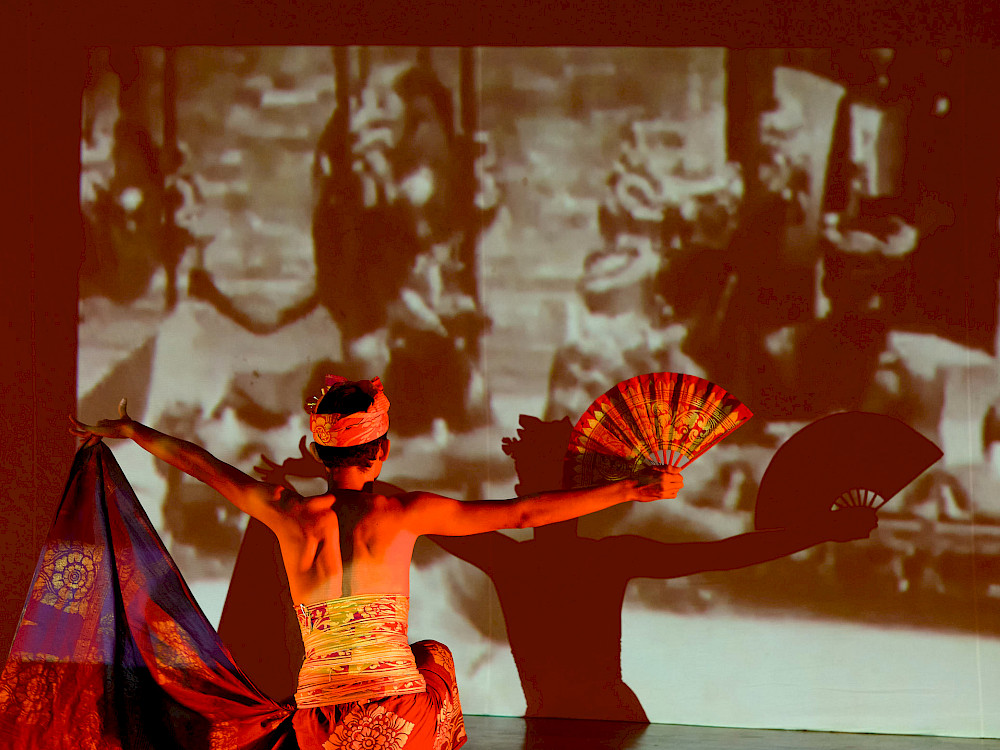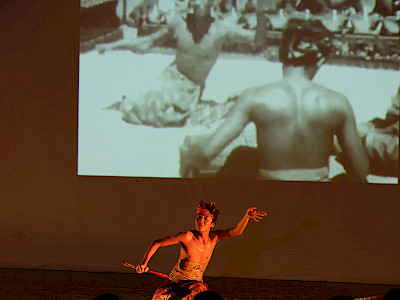20 — 23.05.2025
Mang Tri Ray Dewantara Ubud
Dancing with Marya
dance / lecture performance
| Bahasa Indonesia → FR, NL, EN | ⧖ ±40min | €14 / €11 | Limited capacity
Kebyar Duduk is a Balinese dance known for the seated and half-seated positions of the performer, who also carries a fan. I Ketut Marya (known in the West as I Mario) developed the style 100 years ago through improvisation and interpretative expressions, responding to innovations in gamelan music with faster tempos while blending the masculine and feminine styles of the Balinese Gandrung dance. In the 1930s, his performances were documented by Western anthropologists, including Walter Spies and Beryl de Zoete in the book Dance and Drama in Bali. While this helped preserve the art form, it led to a rigidly codified choreography that contrasted with the original fluidity.
Young Balinese choreographer Mang Tri revisits Marya's archives through innovative re-staging. Dancing with Marya begins as a lecture and gradually transforms as Mang Tri brings the choreography to life, aligning his movements with colonial-period footage of Marya, dancing across eras, gazes, and genders. He explores how Kebyar Duduk has been not only shaped by Western perspectives but also constrained by a tourism industry that values static authenticity over evolution. Mang Tri's sensitive engagement with the archives reopens the possibility of this crystallised dance to finally dance again.
About Dancing with Marya
In Dancing with Marya, I critically explore the archives of Kebyar Duduk, a dance known for its seated and half-seated positions, in which the performer often holds a fan. The dance was developed around a hundred years ago by I Ketut Marya (known in the West as I Mario), and emerged from his improvisational approach in responding to innovations in gamelan music—particularly gamelan kebyar, characterized by its fast tempos and the blending of masculine and feminine elements in traditional Balinese dance. This early form of the dance was fluid and open to interpretation, allowing each dancer to bring their personal style into the structure of the movements.
In the 1930s, several Western artists and researchers began to document the Kebyar Duduk dance, including Walter Spies and Beryl de Zoete in their influential book Dance and Drama in Bali. Walter Spies, a German painter and musician, arrived in Bali in 1927 and settled there to immerse himself in Balinese culture. Spies became integrated into the daily life of the Balinese people and was fascinated by the rich culture and traditional artistic expressions he discovered. He was familiar with every phase of Balinese life and has been a constant source of unbiased information for every archaeologist, anthropologist, musician or artist who has come to Bali. He was the first to appreciate and to record Balinese music, and to collect exemplary patterns of Balinese art. In 1932 Spies helped to create the Bali Museum and collaborated with Balinese artists, co-founding the Pita Maha group, which encouraged the development of traditional Balinese painting in a more expressive and individualistic direction, while still rooted in local values and aesthetics. Along with Beryl de Zoete, Spies played a significant role in promoting Balinese culture to the outside world, documenting Balinese performing arts through writings and records that brought international attention to the cultural richness of Bali during the colonial period.
In turn, Miguel Covarrubias, a Mexican artist and cartoonist, first visited Bali in 1930. In his book Island of Bali, he documented the uniqueness of the Kebyar Duduk dance and the famous dancer I Ketut Marya. Covarrubias approached Balinese culture in a way similar to Walter Spies by interacting directly with the Balinese people and spending time with local artists. He sought to capture the essence of Balinese art through first-hand observation, which he then translated into images and writings that promoted Bali as a cultural destination for Western readers. During his time in Bali, Covarrubias was greatly assisted by Walter Spies, who introduced him to important cultural figures and helped deepen his understanding of Balinese traditions. Despite coming from different cultural backgrounds, both Spies and Covarrubias played important roles in introducing Balinese art and culture to the outside world, particularly during the colonial period, when Bali was still part of the Dutch East Indies.
“As we became more and more familiar with our new life, we were already weary of the stolid prudishness of Dutch hotel life. But somehow we became attached to the household of our first Balinese friend, Gusti Alit Oka, an intelligent and dapper young man, prince by birth, carpenter by profession, and musician by choice. He agreed to rent us one of the pavilions of his house and undertook to improve our Malay. Our household consisted of the young prince’s wife and child, two widowed aunts, and an old servant, a retainer of his father, the great warrior who was killed with his brother the Radja of Badung in their last desperate stand against the invading Dutch army twenty-nine years ago, when our host was a baby. We bought a decrepit Chevrolet and gave ourselves up to the full enjoyment of the island, going from feast to feast, dances, and cremations. It was my good fortune to have made friends in those days with Walter Spies, Bali’s most famous resident. When I could speak fair Malay, I discovered it was not enough. Malay was the trade language between Balinese and foreigners, spoken mainly by the new generations of the towns, so I started to learn a little Balinese to be able to understand the most interesting people of the island—the older men and women.”—Miguel Covarrubias, Island of Bali (Alfred A. Knopf, 1937, New York), pp. 22-23.
Miguel Covarrubias even recorded I Ketut Marya’s performance of the Kebyar Duduk dance in 1931, and this footage has now become an important part of my Dancing with Marya performance. While this documentation played a key role in preserving the dance form, it also led to the rigid codification of its choreography, contrasting with the original fluidity and creative freedom that Marya had introduced. Over time, Kebyar Duduk became increasingly bound by established rules and standards, especially within Bali’s educational institutions, where pakem (convention) became a cornerstone in the dissemination of the dance. This process of standardization led to the gestures becoming homogenized, making the dance less flexible and more aligned with institutional norms. I revisit these archives through innovative re-staging in Dancing with Marya, aligning my movements with colonial-period footage of I Ketut Marya’s performances. In doing so, I dance across eras and viewpoints, bridging the past and present. Through this exploration, I uncover how Kebyar Duduk has been shaped not only by Western perspectives but also constrained by the tourism industry, which often prioritizes static notions of authenticity over the dance’s natural evolution.
Furthermore, I offer a physiological identification of I Ketut Marya’s body, analyzing the variety of movements and bodily expressions he presented in creating Kebyar Duduk. This formal study provides insight into I Ketut Marya’s artistic decisions and how his bodily expression contributed to the dance’s creation. By observing I Ketut Marya through the lens of today’s Kebyar Duduk dancers, I explore the possibilities offered by dance archives while also acknowledging their limitations in fully capturing the past occurrences of body and dance, given the inherently ephemeral nature of dance.
Having studied and traced this dance for approximately 11 years, my deep engagement with Kebyar Duduk has allowed me to develop a nuanced understanding of its evolution and its current interpretations.
Ultimately, Dancing with Marya seeks to reopen the possibility for this “crystallized” dance to once more come back to life, allowing it to transcend its static, codified form and reclaim its original fluidity and creative potential. My lecture-performance is both a critical reflection on the evolution of Kebyar Duduk and an invitation to reimagine its future, reopening the possibility for this dance to finally dance again.
- Mang Tri Ray Dewantara, April 2025
Presentation: Kunstenfestivaldesarts, Beursschouwburg
Choreographer, dancer and writer: Mang Tri Ray Dewantara | Dramaturg and writer: Wayan Sumahardika | Producer and writer: Agus Wiratama | Audio and visual designer: Manik Sukadana | Production manager: Puji Widiani
Production: Mulawali Institute, Mang Tri Ray Dewantara | Coproduction and presenting partners: Indonesian Dance Festival, Tainan Arts Festival (Taiwan)
With the support of Langsai Tititan Nusantara and B-PART (Bali Performing Arts Meeting)


